Mikoyan-Gurevich MiG-21
The Mikoyan-Gurevich MiG-21 (Russian: Микоян и Гуревич МиГ-21; NATO reporting name: Fishbed) is a supersonic jet fighter and interceptor aircraft, designed by the Mikoyan-Gurevich Design Bureau in the Soviet Union. Its nicknames include: Balalaika, because its planform resembles the stringed musical instrument of the same name; Ołówek, Polish for "pencil", due to the shape of its fuselage,[3] and Én Bạc, meaning "Silver Swallow", in Vietnamese.
| MiG-21 | |
|---|---|
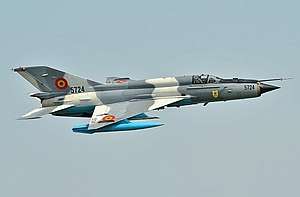 | |
| Romanian MiG-21 Lancer-C in flight | |
| Role | Fighter and interceptor aircraft |
| National origin | Soviet Union |
| Design group | Mikoyan-Gurevich |
| First flight | June 16, 1955 (Ye-4) |
| Introduction | 1959 (MiG-21F) |
| Status | In service |
| Primary users | Soviet Air Forces (historical) Indian Air Force Croatian Air Force Romanian Air Force |
| Produced | 1959–1985 |
| Number built | 11,496[1] (10,645 produced in the USSR, 840 in India, 194 in Czechoslovakia) |
| Unit cost |
MiG-21FL (Indian version): $ 2 million (1974)[2] |
| Variants | Chengdu J-7 |
Approximately 60 countries over four continents have flown the MiG-21, and it still serves many nations six decades after its maiden flight. It made aviation records, became the most-produced supersonic jet aircraft in aviation history, the most-produced combat aircraft since the Korean War and previously the longest production run of a combat aircraft (now exceeded by both the McDonnell Douglas F-15 Eagle and General Dynamics F-16 Fighting Falcon).
Development
Origins
The MiG-21 jet fighter was a continuation of Soviet jet fighters, starting with the subsonic MiG-15 and MiG-17, and the supersonic MiG-19. A number of experimental Mach 2 Soviet designs were based on nose intakes with either swept-back wings, such as the Sukhoi Su-7, or tailed deltas, of which the MiG-21 would be the most successful.
Development of what would become the MiG-21 began in the early 1950s, when Mikoyan OKB finished a preliminary design study for a prototype designated Ye-1 in 1954. This project was very quickly reworked when it was determined that the planned engine was underpowered; the redesign led to the second prototype, the Ye-2. Both these and other early prototypes featured swept wings. The first prototype with delta wings as found on production variants was the Ye-4. It made its maiden flight on 16 June 1955 and its first public appearance during the Soviet Aviation Day display at Moscow's Tushino airfield in July 1956.
In the West, due to the lack of available information, early details of the MiG-21 often were confused with those of similar Soviet fighters of the era. In one instance, Jane's All the World's Aircraft 1960–1961 listed the "Fishbed" as a Sukhoi design and used an illustration of the Su-9 'Fishpot'.
Design
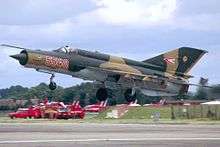
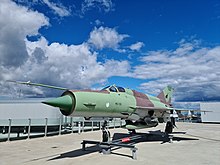
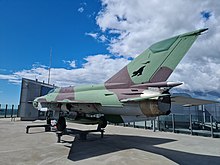
.jpg)
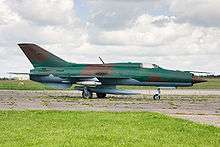
.jpg)
The MiG-21 was the first successful Soviet aircraft combining fighter and interceptor characteristics in a single aircraft. It was a lightweight fighter, achieving Mach 2 with a relatively low-powered afterburning turbojet, and is thus comparable to the American Lockheed F-104 Starfighter and Northrop F-5 Freedom Fighter and the French Dassault Mirage III.[1] Its basic layout was used for numerous other Soviet designs; delta-winged aircraft included Su-9 interceptor and the fast E-150 prototype from MiG bureau while the mass-produced successful front fighter Su-7 and Mikoyan's I-75 experimental interceptor combined a similar fuselage shape with swept-back wings. However, the characteristic layout with the shock cone and front air intake did not see widespread use outside the USSR and finally proved to have limited development potential, mainly because of the very small space available for the radar.
Like many aircraft designed as interceptors, the MiG-21 had a short range. This was exacerbated by the poor placement of the internal fuel tanks ahead of the centre of gravity. As the internal fuel was consumed, the center of gravity would shift rearward beyond acceptable parameters. This had the effect of making the plane statically unstable to the point of being difficult to control, resulting in an endurance of only 45 minutes in clean condition. This can be somewhat countered by carrying fuel in external tanks closer to the center of gravity. The Chinese variants somewhat improved the internal fuel tank layout (also second generation of Soviet variants), and also carry significantly larger external fuel tanks to counter this issue.[4] Additionally, when more than half the fuel was used up, violent maneuvers prevented fuel from flowing into the engine, thereby causing it to shut down in flight. This increased the risk of tank implosions (MiG-21 had tanks pressurized with air from the engine's compressor), a problem inherited from the MiG-15, MiG-17 and MiG-19.[5] The short endurance and low fuel capacity of the MiG-21F, PF, PFM, S/SM and M/MF variants—though each had a somewhat greater fuel capacity than its predecessor—led to the development of the MT and SMT variants. These had an increased range of 250 km (155 mi) compared to the MiG-21SM, but at the cost of worsening all other performance figures, such as a lower service ceiling and slower time to altitude.[1]
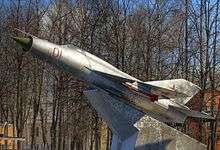
The delta wing, while excellent for a fast-climbing interceptor, meant any form of turning combat led to a rapid loss of speed. However, the light loading of the aircraft could mean that a climb rate of 235 m/s (46,250 ft/min) was possible with a combat-loaded MiG-21bis,[1] not far short of the performance of the later F-16A. Mig-21's Tumansky R-25 jet engine's specialty was the addition of a second fuel pump in the afterburning stage. Activating the ЧР (rus. "чрезвычайный режим" - emergency mode)(Emergency Power Rating, EPR in India) booster feature allows the engine to develop 97.4 kilonewtons (21,896 lbf) of thrust under 2,000 meters (6,600 ft) of altitude. The rpm of the engine would increase by 2.5% and compression ratio would thus increase, with a rise in exhaust temperature. The limit of operation is 2 minutes for both practice and actual wartime use, as further use causes the engine to overheat. The fuel consumption increased by 50% over the rate in full afterburner. Use of this temporary power gave the MiG-21bis slightly better than 1:1 thrust-to-weight ratio and a climbing rate of 254 meters/second, equalling the F-16's nominal capabilities in close-quarters dogfight. The use of WEP thrust was limited to 2 minutes to reduce stress on the engines' 750 (250+250+250) flight hours lifetime, since every second of super-afterburner counted as several minutes of regular power run due to extreme thermal stress. With WEP on, the MiG-21bis's R-25 engine produced a huge 10-12 meter long blowtorch exhaust - with six or seven brightly glowing rhomboid "shock diamonds" visible inside. The Russians gave the emergency-power setting its "diamond regime" name, never used in India.[6] Given a skilled pilot and capable missiles, it could give a good account of itself against contemporary fighters. Its G-limits were increased from +7Gs in initial variants to +8.5Gs in the latest variants.[7] It was replaced by the newer variable-geometry MiG-23 and MiG-27 for ground support duties. However, not until the MiG-29 would the Soviet Union ultimately replace the MiG-21 as a maneuvering dogfighter to counter new American air superiority types.
The MiG-21 was exported widely and remains in use. The aircraft's simple controls, engine, weapons, and avionics were typical of Soviet-era military designs. The use of a tail with the delta wing aids stability and control at the extremes of the flight envelope, enhancing safety for lower-skilled pilots; this in turn enhanced its marketability in exports to developing countries with limited training programs and restricted pilot pools. While technologically inferior to the more advanced fighters it often faced, low production and maintenance costs made it a favorite of nations buying Eastern Bloc military hardware. Several Russian, Israeli and Romanian firms have begun to offer upgrade packages to MiG-21 operators, designed to bring the aircraft up to a modern standard, with greatly upgraded avionics and armaments.[1]
Production
A total of 10,645 aircraft were built in the USSR. They were produced in three factories: AZ 30[N 1] (3,203 aircraft) in Moscow (also known as MMZ Znamya Truda), GAZ 21 (5,765 aircraft) in Gorky [N 2] and TAZ 31 (1,678 aircraft) in Tbilisi. Generally, Gorky built single-seaters for the Soviet forces. Moscow constructed single-seaters for export, and Tbilisi manufactured the twin-seaters both for export and the USSR, though there were exceptions. The MiG-21R and MiG-21bis for export and for the USSR were built in Gorky, 17 single-seaters were built in Tbilisi (MiG-21 and MiG-21F), the MiG-21MF was first constructed in Moscow and then Gorky, and the MiG-21U was built in Moscow as well as in Tbilisi.[1]
| Gorky | 83 MiG-21F; 513 MiG-21F-13; 525 MiG-21PF; 233 MiG-21PFL; 944 MiG-21PFS/PFM; 448 MiG-21R; 145 MiG-21S/SN; 349 MiG-21SM; 281 MiG-21SMT; 2013 MiG-21bis; 231 MiG-21MF |
|---|---|
| Moscow | MiG-21U (all export units); MiG-21PF (all export units); MiG-21FL (all units not built by HAL); MiG-21M (all); 15 MiG-21MT (all) |
| Tbilisi | 17 MiG-21 and MiG-21F; 181 MiG-21U izdeliye 66–400 and 66–600 (1962–1966); 347 MiG-21US (1966–1970); 1133 MiG-21UM (1971 to end) |
A total of 194 MiG-21F-13s were built under licence in Czechoslovakia, and Hindustan Aeronautics Ltd. of India built 657 MiG-21FL, MiG-21M and MiG-21bis (of which 225 were bis)
Design
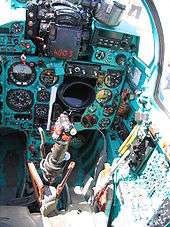
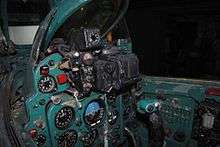
The MiG-21 has a delta wing. The sweep angle on the leading edge is 57° with a TsAGI S-12 airfoil. The angle of incidence is 0° while the dihedral angle is −2°. On the trailing edge there are ailerons with an area of 1.18 m², and flaps with an area of 1.87 m². In front of the ailerons there are small wing fences.
The fuselage is semi-monocoque with an elliptical profile and a maximum width of 1.24 m (4 ft 1 in). The air flow to the engine is regulated by an inlet cone in the air intake. On early model MiG-21s, the cone has three positions. For speeds up to Mach 1.5 the cone is fully retracted to the maximum aft position. For speeds between Mach 1.5 and Mach 1.9 the cone moves to the middle position. For speeds higher than Mach 1.9 the cone moves to the maximum forward position. On the later model MiG-21PF, the intake cone moves to a position based on the actual speed. The cone position for a given speed is calculated by the UVD-2M system using air pressures from in front and behind the compressor of the engine. On both sides of the nose there are gills to supply the engine with more air while on the ground and during takeoff. In the first variant of the MiG-21, the pitot tube is attached to the bottom of the nose. After the MiG-21P variant, this tube is attached to the top of the air intake. Later versions shifted the pitot tube attachment point 15 degrees to the right, as seen from the cockpit and had an emergency pitot head on the right side, just ahead of the canopy and below the pilot's eyeline.
The cabin is pressurized and air conditioned. On variants prior to the MiG-21PFM, the cabin canopy is hinged at the front. When ejecting, the SK-1 ejection seat connects with the canopy to make a capsule that encloses the pilot. The capsule protects the pilot from the high-speed airflow encountered during high-speed ejections. After ejection, the capsule opens to allow the pilot to parachute to the ground. However, ejecting at low altitudes can cause the canopy to take too long to separate, sometimes resulting in pilot death. The minimum height for ejection in level flight was 110 m. Starting from the MiG-21PFM, the canopy is hinged on the right side of the cockpit.
On the under side of the aircraft there are three air brakes, two at the front and one at the rear. The front air brakes have an area of 0.76 m², and a deflection angle of 35°. The rear air brake has an area of 0.46 m² and a deflection angle of 40°. The rear air brake is blocked if the airplane carries an external fuel tank. Behind the air brakes are the bays for the main landing gear. On the under side of the airplane, just behind the trailing edge of the wing are attachment points for two JATO rockets. The front section of the fuselage ends at former #28. The rear section of the fuselage starts at former #28a and is removable for engine maintenance.
The empennage of the MiG-21 consists of a vertical stabilizer, a stabilator and a small fin on the bottom of the tail to improve yaw control. The vertical stabilizer has a sweep angle of 60° and an area of 5.32 m² (on earlier version 3.8 m²) and a rudder. The stabilator has a sweep angle of 57°, an area of 3.94 m² and a span of 2.6 m.
The MiG-21 uses a tricycle type undercarriage. On most variants the main landing gear uses tires that are 800 mm in diameter and 200 mm in width. Only the MiG-21F variants use tires with the size 660×200 mm. The wheels of the main landing gear retract into the fuselage after rotating 87° and the shock absorbers retract into the wing. The nose gear retracts forward into the fuselage under the radar. The nose wheel can be lowered manually by simply unlocking its hatch from inside the cockpit. Thus, landing with undercarriage locked in the up position due to an internal failure was not a major issue, with a number of such successful landings on the nosewheel and ventral fuel tank or the airbrake.
Operational history
India
Overview
India is the largest operator of MiG-21s. In 1961, the Indian Air Force (IAF) opted to purchase the MiG-21 over several other Western competitors. As part of the deal, the Soviet Union offered India full transfer of technology and rights for local assembly.[9] In 1964, the MiG-21 became the first supersonic fighter jet to enter service with the IAF. Due to limited induction numbers and lack of pilot training, the IAF MiG-21 played a limited role in the Indo-Pakistani War of 1965.[10] However, the IAF gained valuable experience while operating the MiG-21 for defensive sorties during the war.[10] The positive feedback from IAF pilots during the 1965 war prompted India to place more orders for the fighter jet and also invest heavily in building the MiG-21's maintenance infrastructure and pilot training programs.
Since 1963, India has introduced more than 1,200 MiG fighters into its air force. As of 2019, 113 MiG-21s are known to be in operation in the IAF.[11] However, the plane has been plagued by safety problems. Since 1970 more than 170 Indian pilots and 40 civilians have been killed in MiG-21 accidents. At least 14 MiG-21s have crashed between 2010 and 2013.[12] Over half of the 840 aircraft built between 1966 and 1984 were lost to crashes.[13] When in afterburner, the engine operates very close to its surge line and the ingestion of even a small bird can lead to an engine surge/seizure and flame out.
On 11 December 2013, India's second-generation supersonic jet fighter, MiG-21FL was decommissioned after being in service for 50 years. [14]
In view of the several incidents that have occurred after the 1999 Kargil War, the modernized MiG-21 Bison seems to have at present the role of an interceptor and possibly a limited role of a fighter aircraft.[15][16]
1971 Indo-Pakistan War
The expansion of IAF MiG-21 fleet marked a developing India-Soviet Union military partnership, which enabled India to field a formidable air force to counter Chinese and Pakistani threats.[17] The capabilities of the MiG-21 were put to the test during the Bangladesh Liberation War. During the war, the MiG-21s played a crucial role in giving the IAF air superiority over vital points and areas in the western theater of the conflict.[18]
The 1971 war witnessed the first supersonic air combat in the subcontinent when an Indian MiG-21FL claimed a PAF F-104A Starfighter with its GSh-23 twin-barrelled 23 mm cannon.[19] By the time the hostilities came to an end, the IAF MiG-21FLs had claimed four PAF F-104As, two PAF Shenyang F-6, one PAF North American F-86 Sabre and one PAF Lockheed C-130 Hercules. According to one Western military analyst, the MiG-21FLs had clearly "won" the much anticipated air combat between the MiG-21FL and the F-104A Starfighter.[20]
Because of the performance of India's MiG-21s, several nations, including Iraq, approached India for MiG-21 pilot training. By the early 1970s, more than 120 Iraqi pilots were being trained by the Indian Air Force.[21]
Kargil War
One MiG-21 was shot down by a Pakistani soldier using a shoulder-fired MANPADS missile during the Kargil war.[22]
On 10 August 1999, two MiG -21FLs of the Indian Air Force intercepted and shot down a Pakistan's Naval Air Arms Atlantic maritime patrol aircraft with an R-60 missile after it allegedly entered Indian airspace for surveillance, killing all on board.[22]
2019 Jammu and Kashmir airstrikes
During Operation Swift Retort on 27 February 2019, an Indian MiG-21 Bison was shot down during a clash between Indian and Pakistani aircraft.[23]
Indonesia
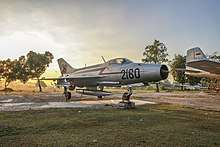
The Indonesian Air Force purchased 22 MiG-21s. In 1962, 20 MiG-21F-13s and MiG-21Us were received during Operation Trikora in the Western New Guinea conflict. Indonesian MiG-21s never fought in any dogfights. Right after the U.S. backed anti-communist forces took over the government, 13 Indonesian MiG-21s were delivered to the U.S. in exchange for T-33, UH-34D, and later, F-5 and OV-10 aircraft. All remaining MiG-21s were grounded and retired due to lack of spare parts and the withdrawal of Soviet maintenance support.
The MiGs were added to the 4477th Test and Evaluation Squadron ("Red Eagles"), an USAF aggressor squadron at Tonopah Test Range.[24]
Vietnam
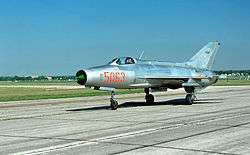
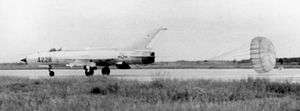
.jpg)
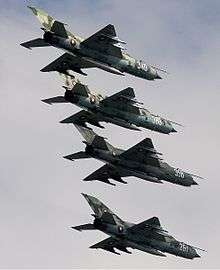
As may be seen from its range figures, the MiG-21 was designed for very short ground-controlled interception (GCI) missions. It became renowned for this type of mission in the skies over North Vietnam.[25] The first MiG-21s arrived directly from the Soviet Union by ship in April 1966. After being unloaded and assembled[26] they were given to the Vietnam People's Air Force's (VPAF) oldest fighter unit, the 921st Fighter Regiment (921st FR), which had been created on 3 February 1964 as a MiG-17 unit. Because the VPAF's 923rd FR was newer and less experienced, they would continue to operate MiG-17s, while the arrival of the MiG-19s (J6 versions) from China in 1969 would create North Vietnam's only MiG-19 unit, the 925th FR. On 3 February 1972, North Vietnam commissioned their fourth and last fighter regiment created during the war with South Vietnam, the MiG-21PFM (Type 94) equipped 927th Fighter Regiment.[27]
Although 13 of North Vietnam's flying aces attained their status while flying the MiG-21 (cf. three in the MiG-17), many VPAF pilots preferred the MiG-17 because the high wing loading of the MiG-21 made it relatively less maneuverable and the lighter framed canopy of the MiG-17 gave better visibility.[28] However, this is not the impression perceived by British author Roger Boniface when he interviewed Pham Ngoc Lan and ace Nguyễn Nhật Chiêu (who scored victories flying both MiG-17 and MiG-21).[29][30] Pham Ngoc Lan told Boniface that "The MiG-21 was much faster, and it had two ATOLL missiles which were very accurate and reliable when fired between 1,000 and 1,200 yards."[31][32] And Chiêu asserted that "... for me personally I preferred the MiG-21 because it was superior in all specifications in climb, speed and armament. The ATOLL missile was very accurate and I scored four kills with the ATOLL. ... In general combat conditions I was always confident of a kill over an F-4 Phantom when flying a MiG-21."[33][34]
Although the MiG-21 lacked the long-range radar, missiles, and heavy bomb load of its contemporary multi-mission U.S. fighters, with its RP-21 Sapfir radar it proved a challenging adversary in the hands of experienced pilots, especially when used in high-speed hit-and-run attacks under GCI control. MiG-21 intercepts of Republic F-105 Thunderchief strike groups were effective in downing US aircraft or forcing them to jettison their bomb loads.
Aerial combat victories 1966–1972
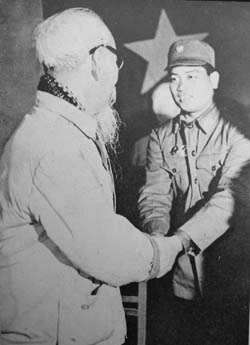
The VPAF flew their interceptors with guidance from ground controllers, who positioned the MiGs in ambush battle stations to make their "one pass, then haul ass" attacks.[38] The MiGs made fast and often accurate attacks against US formations from several directions (usually the MiG-17s performed head-on attacks and the MiG-21s attacked from the rear). After shooting down a few American planes and forcing some of the F-105s to drop their bombs prematurely, the MiGs did not wait for retaliation, but disengaged rapidly. These "guerrilla warfare in the air" tactics[38] generally proved successful during the course of the war. In December 1966 the MiG-21 pilots of the 921st FR downed 14 F-105 Thunderchiefs without any losses.[39]
The USAF and the US Navy had high expectations of the F-4 Phantom, assuming that the massive firepower, the best available on-board radar, the highest speed and acceleration properties, coupled with new tactics, would provide Phantoms with an advantage over the MiGs. But in confrontations with the lighter MiG-21, F-4s began to suffer losses. From May to December 1966, the USAF lost 47 aircraft, destroying only 12 VPAF fighters in return. From April 1965 to November 1968, over 268 air battles occurred over the skies of North Vietnam. North Vietnam claimed 244 downed U.S. aircraft, while admitting to the loss of 85 MiGs. Of these, 46 air battles conducted between F-4s and MiG-21s – the losses were 27 F-4 Phantoms and 20 MiG-21s.[40]
After a million sorties and nearly 1,000 US aircraft losses, Operation Rolling Thunder came to an end on 1 November 1968.[41] A poor air-to-air combat loss-exchange ratios against the smaller, more agile enemy MiGs during the early part of the war eventually led the US Navy to create their Navy Fighter Weapons School, also known as "TOPGUN", at Naval Air Station Miramar, California, on 3 March 1969.[42] The USAF quickly followed with their own version, titled the Dissimilar Air Combat Training (sometimes referred to as Red Flag) program at Nellis Air Force Base, Nevada. These two programs employed the subsonic Douglas A-4 Skyhawk and the supersonic F-5 Tiger II, as well as the Mach 2.4-capable USAF Convair F-106 Delta Dart, which mimicked the MiG-21.[43]
The culmination of the struggle in the air in early 1972 was 10 May, when VPAF aircraft completed 64 sorties, resulting in 15 air battles. The VPAF claimed 7 F-4s were shot down (U.S. confirmed five F-4s were lost.[44]) Those, in turn, managed to destroy two MiG-21s, three MiG-17s and one MiG-19. On 11 May, two MiG-21s, who played the role of "bait", brought four F-4s to 2 MiG-21s circling at low altitude. The MiGs quickly stormed the Phantoms and 3 missiles shot down two F-4s. On 13 May, a MiG-21 unit intercepted a group of F-4s, the second pair of MiGs made a missile attack and were hit by two F-4s. 18 May, VPAF aircraft made 26 sorties, eight of which resulted in combat, costing four F-4s while the VPAF did not suffer any losses.
Over the course of the air war, between 3 April 1965[45] and 8 January 1973, each side would ultimately claim favorable kill ratios. In 1972 the tally between American and Vietnamese planes stood at 201 air battles. The VPAF lost 54 MiGs (including 36 MiG-21s and one MiG-21US) and they claimed 90 U.S. aircraft were shot down, including 74 F-4 fighters and two RF-4C reconnaissance jets (MiG-21 shot down 67 enemy aircraft, MiG-17 shot down 11 and MiG-19 shot down 12 enemy aircraft).
One MiG-21 was shot down on 21 February 1972 by a USAF F-4 Phantom piloted by Major Lodge with 1st Lt Roger Locher as his WSO based at Udorn RTAFB, Thailand. This was claimed to be the first ever USAF MiG kill at night, and the first in four years at that time.
Two MiG-21s were claimed shot down by USAF Boeing B-52 Stratofortress tail gunners; the only confirmed air-to-air kills made by the B-52. The first aerial victory occurred on 18 December 1972 by tail gunner SSgt Samuel Turner, who was awarded the Silver Star.[46] The second air-to-air kill took place on 24 December 1972, by A1C Albert E. Moore downing a MiG-21 over the Thai Nguyen railroad yards. Both actions occurred during Operation Linebacker II (also known as the Christmas Bombings).[47] These air-to-air kills were not confirmed by VPAF.
.jpg)
The biggest threat to North Vietnam during the war had always been the Strategic Air Command's B-52 Stratofortress. Hanoi's MiG-17 and MiG-19 interceptors could not deal with those bombers at their flying altitude. In summer 1972 the VPAF was directed to train 12 MiG-21 pilots for the specific mission of attacking and shooting down B-52 bombers, with two-thirds of those pilots specifically trained in the night attack.[48] On 26 December 1972, just two days after tail gunner Albert Moore downed his MiG-21, a VPAF MiG-21MF (number 5121)[49] from the 921st Fighter Regiment, flown by Major Phạm Tuân over Hanoi, claimed the first aerial combat kill of a B-52.[50] The B-52 had been above Hanoi at over 30,000 feet (9,100 m), when Major Tuân launched two Atoll missiles from 2 kilometres, claiming to have destroyed one of the bombers flying in the three-plane formation.[50] Other sources argue that his missiles failed to hit their mark, but as he was disengaging, a B-52 from a three-bomber cell in front of his target took a hit from a SAM, exploding in mid-air: this may have caused Tuân to think his missiles destroyed the target he had been aiming for.[51]
The Vietnamese claim another kill to have taken place on 28 December 1972 by a MiG-21 from the 921st FR, this time flown by Vu Xuan Thieu. Thieu is said to have perished in the explosion of a B-52 hit by his own missiles, having approached the target too closely.[52] In this case the Vietnamese version appears to be erroneous: while one MiG-21 kill was claimed by Phantoms that night (this may have been Thieu's MiG), no B-52s were lost to any cause on the date of the claimed kill.[53]
- Year-by-year kill claims involving MiG-21s[1]
- 1966: U.S. claimed six MiG-21s destroyed; North Vietnam claimed seven F-4 Phantom IIs and 11 F-105 Thunderchiefs shot down by MiG-21s.
- 1967: U.S. claimed 21 MiG-21s destroyed; North Vietnam claimed 17 F-105 Thunderchiefs, 11 F-4 Phantom IIs, two RF-101 Voodoos, one A-4 Skyhawk, one Vought F-8 Crusader, one EB-66 Destroyer and three unidentified types shot down by MiG-21s.
- 1968: U.S. claimed nine MiG-21s destroyed; North Vietnam claimed 17 US aircraft shot down by MiG-21s.
- 1969: U.S. destroyed three MiG-21s; one Firebee UAV destroyed by a MiG-21.
- 1970: U.S. destroyed two MiG-21s; North Vietnam claimed one F-4 Phantom and one CH-53 Sea Stallion helicopter shot down by MiG-21s.
- 1972: U.S. claimed 51 MiG-21s destroyed; North Vietnam claimed 53 US aircraft shot down by MiG-21s, including two B-52 Stratofortress bombers. Soviet General Fesenko, the main Soviet adviser to the North Vietnamese Air Force in 1972,[52] recorded 34 MiG-21s destroyed in 1972.[52]
On 3 January 1968, a MiG-21 pilot, Ha Van Chuc, alone entered into battle with 36 American planes and claimed one F-105 Thunderchief.[54]
During the war, the VPAF claimed 103 F-4 Phantoms were shot down by MiG-21s, and they lost 60 MiG-21s in air combat (54 by Phantoms).[55][1]
According to Russian data, in air battles the VPAF MiG-21s claimed 165 air victories, with the loss of 65 aircraft (few by accident or friendly fire) and 16 pilots. The losses of MiG-21 pilots were the smallest in comparison with all other airplanes.[56]
Egyptian–Syrian–Israeli conflicts
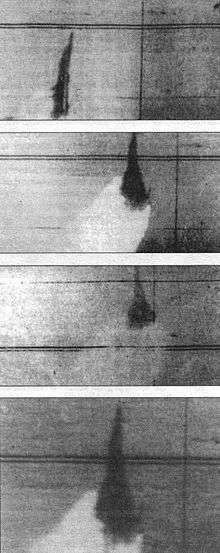
The MiG-21 was also used extensively in the Middle East conflicts of the 1960s, 1970s and 1980s by the Egyptian Air Force, Syrian Air Force and Iraqi Air Force. The MiG-21 first encountered Israeli Mirage IIICs on 14 November 1964, but it was not until 14 July 1966 that the first MiG-21 was shot down. Another six Syrian MiG-21s were shot down by Israeli Mirages on 7 April 1967. MiG-21s also faced McDonnell Douglas F-4 Phantom IIs and Douglas A-4 Skyhawks, but were later outclassed by the more modern McDonnell Douglas F-15 Eagle and General Dynamics F-16 Fighting Falcon, which were acquired by Israel beginning in the mid-1970s. During this period, Syrian pilots flying Mig-21s also independently discovered the Cobra maneuver which became a standard defensive maneuver under the name "zero speed maneuver" (Syrian: مناورة السرعة صفر).[57]
During the opening attacks of the 1967 Six-Day War, the Israeli Air Force struck Arab air forces in four attack waves. In the first wave, IDF aircraft claimed to have destroyed eight Egyptian aircraft in air-to-air combat, of which seven were MiG-21s; Egypt claimed five kills scored by MiG-21PFs.[58] During the second wave Israel claimed four MiG-21s downed in air-to-air combat, and the third wave resulted in two Syrian and one Iraqi MiG-21s claimed destroyed in the air. The fourth wave destroyed many more Syrian MiG-21s on the ground. Overall, Egypt lost around 100 out of about 110 MiG-21s they had, almost all on the ground; Syria lost 35 of 60 MiG-21F-13s and MiG-21PFs in the air and on the ground.[1]
Between the end of the Six-Day War and the start of the War of Attrition, IDF Mirage fighters had six confirmed kills of Egyptian MiG-21s, in exchange for Egyptian MiG-21s scoring two confirmed and three probable kills against Israeli aircraft. During this same time period, from the end of the Six Day War to the end of the War of Attrition, Israel claimed a total of 25 Syrian MiG-21s destroyed; the Syrians claimed three confirmed and four probable kills of Israel aircraft, although Israel denied these.[1]
High losses to Egyptian aircraft and continuous bombing during the War of Attrition caused Egypt to ask the Soviet Union for help. In March 1970, Soviet pilots and SAM crews arrived with their equipment. On 13 April, during the air battle over the Red Sea coast, the Soviet MiG-21MFs, according to some data, shot down two Israeli F-4 fighters[59][60] On 18 April, one Israeli scout RF-4E "Phantom" were damaged by Soviet MiG-21MF.[60] On 16 May, an Israeli aircraft is shot down in air combat, probably by a Soviet MiG-21[61] On 22 June 1970, a Soviet pilot flying a MiG-21MF shot down an Israeli A-4E. After that, some more successful intercepts by Soviet pilots and another Israeli A-4 being shot down on 25 June.[60]
Israel decided to plan an ambush (Operation Rimon 20) in response. On 30 July, Israeli F-4s lured Soviet MiG-21s into an area where they were ambushed by Mirages. Asher Snir, flying a Mirage IIICJ, destroyed a Soviet MiG-21; Avihu Ben-Nun and Aviam Sela, both piloting F-4Es, each got a kill, and an unidentified pilot in another Mirage scored the fourth kill against the Soviet-flown MiG-21s; while the IAF suffers no losses except a damaged Mirage. Three Soviet pilots were killed and the Soviet Union was alarmed by the losses. While a morale boosting achievement, Rimon 20 did not change the course of the war. After the operation, other IAF aircraft were lost to Soviet MiG-21s and SAMs. Few days later, on 7 August, the Soviets respond by luring Israeli fighter jets into a counter-ambush, downing two Israeli Mirage-IIICs[62] and deploying more aircraft to Egypt, known as "Operation Kavkaz". Totally, during March – August 1970, Soviet MiG-21 pilots and SAM crews destroyed a total of 21 Israeli aircraft (eight by SA-3 missile systems and 13 by MiG-21s) at a cost of 5 MiG-21s were shot down by IAF, which helped to convince the Israelis to sign a ceasefire agreement.[63]
In September 1973, a large air battle erupted between Syria and Israel; Israel claimed a total of 12 Syrian MiG-21s destroyed, while Syria claimed eight kills scored by MiG-21s and admitted five losses.
During the Yom Kippur War, Israel claimed 73 kills against Egyptian MiG-21s (65 confirmed). Egypt claimed 27 confirmed kills against Israeli aircraft by its MiG-21s, plus eight probables.[1] However, according to most Israeli sources, these were exaggerated claims as Israeli air-to-air combat losses for the entire war did not exceed five to fifteen.[64][65]
On the Syrian front of the war, 6 October 1973 saw a flight of Syrian MiG-21MFs shoot down an IDF A-4E and a Mirage IIICJ while losing three of their own to Israeli IAI Neshers. On 7 October, Syrian MiG-21MFs downed two Israeli F-4Es, three Mirage IIICJs and an A-4E while losing two of their MiGs to Neshers and one to an F-4E, plus two to friendly SAM fire. Iraqi MiG-21PFs also operated on this front, and on that same day destroyed two A-4Es while losing one MiG. On 8 October 1973, Syrian MiG-21PFMs downed three F-4Es, but six of their MiG-21s were lost. By the end of the war, Syrian MiG-21s claimed a total of 30 confirmed kills against Israeli aircraft; 29 MiG-21s were claimed (26 confirmed) as destroyed by the IDF.[1]
Between the end of the Yom Kippur War and the start of the 1982 Lebanon War, Israel had received modern F-15s and F-16s, which were far superior to the old Syrian MiG-21MFs. According to the IDF, these new aircraft accounted for the destruction of 24 Syrian MiG-21s over this period, though Syria did claim five kills against IDF aircraft with their MiG-21s armed with outdated K-13 missiles; Israel denied they suffered any losses.[1]
The 1982 Lebanon War started on 6 June 1982, and in the course of that war the IDF claimed to have destroyed about 45 Syrian MiG-21MFs. Syria claimed two confirmed and 15 probable kills of Israeli aircraft.[1] Two Israeli F-15 and one F-4 were damaged in combat with the MiG-21.[66][67] This air battle was the largest to occur since the Korean War.
Syrian civil war
Starting in July 2012, after more than a year of the Syrian civil war had seen no aerial action, the Syrian Air Force started operations against Syrian insurgents. MiG-21s were among the first combat ready aircraft used in bombings, rocket attacks and strafing runs with many videos recorded from the ground showing the jets in combat.[68]
The rebels had access to heavy machine guns, different anti-aircraft guns and Russian and Chinese MANPADS up to modern designs such as the FN-6. The first loss of a MiG-21 was recorded on 30 August 2012. Its registration was 2271. It was likely downed on takeoff or landing at Abu al-Duhur Military Airbase, under siege by rebels, by heavy machine gun fire.[69] A few days later a second MiG-21, registered 2280, was shot down and recorded on video on 4 September 2012. It was likely downed on takeoff or landing at Abu Dhuhur air base, under siege by rebels, by KPV 14.5 mm machine gun fire.[70]
On 10 November 2014, a Syrian Air Force MiG-21bis, serialed 2204, was shot down by rebels either using a MANPADS or antiaircraft guns, near Sabboura town, 45 km east of Hama airbase where it was likely based. The pilot was killed. Video and picture evidence of the crash site surfaced.[71][72]
After four months, during which the Syrian Air Force suffered no losses to enemy fire, the last being a MiG-23, on 12 March 2016, a Syrian MiG-21 was shot down by Jaysh al-Nasr over Hama near Kafr Nabudah. There were conflicting accounts of how it was brought down, the Syrian Observatory for Human Rights reported the warplane had been downed by two MANPADS, while Jaysh al-Nasr militants say they shot it down with anti-aircraft guns.[73] Video evidence suggesting it was a MANPADS. It seems the pilot ejected, but died, either killed by ground fire while descending or other causes.[74]
On 4 March 2017, SyAAF MiG-21bis from No. 679 squadron operating from Hama AB and piloted by Col. Mohammad Sawfan was shot down by rebels and subsequently crashed in Turkish territory nearby the borders; the pilot in question has successfully ejected but been arrested and taken to a hospital in Antakya. The pilot returned to service recently and this mission was his first sortie after suspension years before. A recording of the last conversation between the pilot and the ground controller, clearly shows the pilot disorientation due to a technical failure with a malfunctioning compass first then the whole navigation system. After that the pilot could not recognize his way back to base, as requested by the ground controller and ended under range of AAA of Ahrar Al-Sham rebels.[75]
Libyan–Egyptian War
Egypt was shipped some American Sidewinder missiles, and these were fitted to their MiG-21s and successfully used in combat against Libyan Mirages and MiG-23s during the brief Libyan-Egyptian War of July 1977.
| Date | Aircraft scoring kill | Victim |
|---|---|---|
| 22 July 1977 | LARAF Mirage 5DE | EAF MiG-21MF |
| 23 July 1977 | EAF MiG-21MFs | 3 (or 4) LARAF Mirage + 1 LARAF MiG-23MS |
| 1979 | EAF MiG-21MF | LARAF MiG-23MS |
Iran–Iraq War
During the Iran–Iraq War, 23 Iraqi MiG-21s were shot down by Iranian F-14s, confirmed by the Iranian, Western and Iraqi sources[76] and 29 MiG-21s by F-4s.[77] However, from 1980 to 1988, the Iraqi MiG-21s shot down 43 Iranian fighter aircraft against 49 MiG-21 losses in the same period.[78][79]
Libya
Libyan Civil War (2011)
Libyan MiG-21s saw limited service during the 2011 Libyan civil war.[80] On 15 March 2011, one MiG-21bis and one MiG-21UM flown by defector Libyan air force pilots who joined the rebellion, flew from Ghardabiya AB (near Sirte) and landed at Benina airport to become part of the Free Libyan Air Force. On 17 March 2011 the MiG-21UM suffered a technical fault and crashed after takeoff from Benina airport.[81]
Libyan Civil War (2014–present)
In the ongoing Second Libyan Civil War (2014–present), the Libyan National Army, under the command of Khalifa Haftar is loyal to the legislative body in Tobruk, which is the Libyan House of Representatives, internationally recognised until October 2015. It fights against the now internationally recognized Government of National Accord and the Shura Council of Benghazi Revolutionaries as well as Islamic State in Libya which are common enemies for both the Government of National Accord and the Libyan National Army. Both the Libyan National Army and the Government of National Accord field small airforces. As such, a number of former Libyan Arab Air Force (LARAF) MiG-21s were returned to service with the Tobruk-based Libyan National Army, thanks to spare parts and technical assistance from Egypt and Russia, while a number of former Egyptian Air Force MiG-21s were pressed into service as well.[82] MiG-21s under the control of the Libyan House of Representatives have been used extensively to bomb forces loyal to the rival General National Congress in Benghazi during the 2014 Libyan Civil War.[83][84]
On 29 August 2014, a LNA MiG-21bis, serial number 208, after a bombing mission over Derna, crashed in Bayda according to an official statement as a result of a technical failure of the plane, while Islamist Shura Council of Benghazi Revolutionaries claimed it was shot down. The pilot did not eject and died in the crash.[85][86]
On 2 September 2014 a LNA MiG-21bis, serial number 800, crashed in a city block of Tobruk, due to pilot error during a pull up maneuver.[87] It is unclear whether the pilot had been on a bombing mission on the way to Derna, further East or had been performing an aerial ceremony for the MiG-21 pilot who died few days earlier.[88]
Part of the 2019 Western Libya offensive, on 9 April 2014, a Libyan National Army MiG-21 made a low altitude diving rocket attack, probably firing S-24 rockets on Mitiga airport in Tripoli, making limited damages to one of the runways.[89] On 14 April 2019, a Libyan National Army MiG-21MF was shot down by a surface-to-air missile, probably a MANPADS fired by the forces of the Libyan Government of National Accord (GNA) south of Tripoli. Video evidence confirmed the MiG-21 came under fire from anti aircraft guns, small arms and two SAMs, one of which apparently hit the target. The pilot, Colonel Jamal Ben Amer ejected safely and recovered to LNA held territory by a Mi-35 helicopter. LNA sources confirmed the loss, but blaming a technical problem.[90][91][92][93]
Horn of Africa
During the Ogaden War of 1977–78, Ethiopian Air Force F-5As engaged Somali Air Force MiG-21MFs in combat on several occasions. In one lopsided incident, two F-5As piloted by Israeli advisers or mercenaries engaged four MiG-21MFs. The MiGs were handled incompetently by the Somali pilots, and the F-5As destroyed two while the surviving pilots collided with each other avoiding an AIM-9.[1][94]
Ethiopia claimed to have shot down 10 Somali MiG-21MFs; while Somalia also claimed to have destroyed several Ethiopian MiG-21MFs, three F-5Es, one Canberra bomber and three Douglas DC-3s.[1] Ethiopian MiG-21s were deployed largely in the ground attack role, and proved instrumental during the final offensive against Somali ground forces.[1]
Ethiopian pilots who had flown both the F-5 and the MiG-21 and received training in both the USA and the USSR considered the F-5 to be the superior fighter because of its manoeuvrability at low to medium speeds, its superior instrumentation and the fact that it was far easier to fly, allowing the pilot to focus on combat rather than controlling his airplane.[95] This effect was enhanced by the poor quality of pilot training provided by the Soviets, which provided limited flight time and focussed exclusively on taking off and landing, with no practical training in air combat.[95][96]
Angola
During Angola's long-running civil war, MiG-21s of the Cuban Air Force were frequently deployed to attack ground targets manned by rebel forces or engage South African Air Force Mirage F1s conducting cross-border strikes. Most MiG-21 losses over Angola were attributed to accurate ground fire, such as an example downed by National Union for the Total Independence of Angola (UNITA) insurgents near Luena with an American FIM-92 Stinger.[97]
Despite extensive losses to man-portable air-defense systems, MiG-21s were instrumental during the Battle of Cuito Cuanavale; Cuban pilots became accustomed to flying up to three sorties a day. Both the MiG-21MF and the MiG-21bis were deployed almost exclusively in the fighter/bomber role. As interceptors they were somewhat unsuccessful due to their inability to detect low-flying South African aircraft.[98] On 6 November 1981, a Mirage F1CZ achieved South Africa's first confirmed air-to-air kill since the Korean War when it destroyed Cuban Lieutenant Danacio Valdez's MiG-21MF with 30mm cannon fire.[99] On 5 October 1982, Mirages escorting an English Electric Canberra on routine reconnaissance over Cahama were engaged by at least two MiG-21bis. A South African radar operator picked up the attacking MiGs and was able to alert the Mirage pilots in advance, instructing them to change course immediately. As they jettisoned their auxiliary tanks, however, they were pinpointed by the Cubans, who opened pursuit. In a vicious dogfight, SAAF Major Johann Rankin closed range and maneuvered into the MiGs' rear cones. From there, one of his two R.550 Magic missiles impacted directly behind the lead MiG and forced it down. The second aircraft, piloted by a Lieutenant Raciel Marrero Rodriguez, could not detect the Mirage's proximity until it had entered his turn radius and was perforated by Rankin's autocannon. This damaged MiG-21 landed safely at Lubango.[99]
Contacts between MiG-21s and SAAF Mirage F1s or Mirage IIIs became increasingly common throughout the 1980s. Between 1984 and 1988, thirteen MiG-21s were lost over Angola.[100] On 9 August 1984, a particularly catastrophic accident occurred when the 9th Fighter Training Squadrons and the 12th Fighter Squadrons of the Cuban Air Force attempted to carry out an exercise in poor weather. A single MiG-21bis and three MiG-23s were lost.[98]
On 14 December 1988, an Angolan Air Force MiG-21bis, serial number C340, strayed off course and being low on fuel executed an emergency landing on an open field in South West Africa, modern day Namibia, where it was seized by local authorities. Since Angola did not request its return after the South African Border War, the MiG was restored by Atlas Aviation and till September 2017 it was displayed at Swartkops Air Force Base, Pretoria.[101] The jet was returned to Angola, flying in an Angolan Il-76 cargo plane, as a sign of goodwill on 15 September 2017.[102]
Congo
The MiG-21MFs of the 25th Fighter Aviation Regiment of the National Air Force of Angola flew ground sorties during the Second Congo War, sometimes being piloted by mercenaries. The Chinese-made F-7 Skybolt also saw combat with the Air Force of Zimbabwe.[103] Some six MiG-21s were imported into the country during the First Congo War for the Congo Air Force, but do not appear to have seen operational service. (Cooper and Weinert, "African MiGs: Volume 1: Angola to Ivory Coast").
Yugoslavia
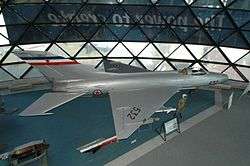
Yugoslavia purchased its first batch of MiG-21s in 1962 from the Soviet Union. In the period from 1962 to the early 1980s Yugoslavia had purchased 261 MiG-21s in ten variants. There was 41 MiG-21f-13, 36 MiG-21PfM, 25 MiG-21M, 6 MiG-21MF, 46 MiG-21bis, 45 MiG-21bisK, 12 MiG-21R, 18 MiG-21U, 25 MiG-21UM and 7 MiG-21US.[104] Yugoslav Air force units that operated MiG-21 were the 204th Fighter-Aviation Regiment at Batajnica Air Base (126th, 127th and 128th fighter-aviation squadrons), 117th fighter-aviation regiment at Željava Air Base (124th and 125th fighter-aviation squadron and 352nd recon squadron), 83rd fighter-aviation regiment at Slatina Air Base (123rd and 130th fighter aviation squadron), 185th fighter-bomber-aviation squadron (129th fighter-aviation squadron) at Pula and 129th training center at Batajnica air base.
During the early stages of the 1990s' Yugoslav wars the Yugoslav military used MiG-21s in a ground-attack role, while Croatian and Slovene forces did not have air forces at the beginning of the war. Aircraft from air bases in Slovenia, Croatia, and Bosnia and Herzegovina were relocated to air bases in Serbia. Detailed records show at least seven MiG-21s were shot down by AA defenses in Croatia and Bosnia.[105] A MiG-21 shot down an EC helicopter in 1992.[106]
Croatia acquired three MiG-21s in 1992 through defections by Croatian pilots serving with the JNA,[107] two of which were lost in subsequent actions – one to Serbian air defenses, the other in a friendly fire accident.[108] In 1993, Croatia purchased about 40 MiG-21s in violation of an arms embargo,[108] but only about 20 of these entered service, while the rest were used for spare parts. Croatia used them alongside the sole remaining defector for ground attack missions in operations Flash (during which one was lost) and Storm. The only air-to-air action for Croatian MiGs was an attempt by two of them to intercept Soko J-22 Oraos of Republika Srpska's air force on ground attack mission on 7 August 1995. After some maneuvering, both sides disengaged without firing.[108]
Remaining Yugoslav MiG-21s were flown to Serbia by 1992 and continued their service in the newly created Federal Republic of Yugoslavia. During the 1999 NATO bombing of Yugoslavia, 3 MiG-21s were destroyed on the ground.[105]
Romania
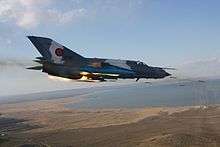
In 1962, Romanian Air Force (RoAF) received first 12 MiG-21F-13, followed by another 12 of the same variant in 1963. Deliveries continued over the next years with other variants: 38 aircraft of MiG-21RFM (PF) variant in 1965, 7 MiG-21U-400/600 in 1965–1968, 56 MiG-21RFMM (PFM) in 1966–1968, 12 MiG-21R in 1968–1972, 68 MiG-21M plus 11 MiG-21US in 1969–1970, 74 MiG-21MF/MF-75 in 1972–1975, and 27 MiG-21UM in 1972–1980 plus another 5 of the same variant in 1990, for a total number of 322 aircraft.[109]
Beginning in 1993, Russia did not offer spare parts for the MiG-23 and MiG-29 for the RoAF. Initially, this was the context for the modernization of the Romanian MiG-21s with Elbit Systems, and because it was easier to maintain these fighter jets. In 1995–2002, a total of 111 MiG-21s were modernized, of which 71 were M and MF/MF-75 variants modernized under the LanceR A designation (for ground attack), 14 were UM variant as LanceR B designation (trainer), and another 26 MF/MF-75 variant were modernized under LanceR C designation (air superiority).[109] Today, only 36 LanceRs are operational for the RoAF. It can use both Western and Eastern armament such as the R-60M, R-73, Magic 2, or Python III missiles.
They will be replaced by a squadron of 12 F-16AM/BM fighters by 2020 with the first aircraft arriving in the second half of 2016. Another squadron will be purchased with newer versions of the F-16 or other types of multirole plane jets like Dassault Rafale-B/C/M, used McDonnell-Douglas F/A-18C/D Hornet, Boeing F/A-18E/F Super Hornet or Eurofighter Typhoon, to complete the minimum number of 48 multirole fighters, required in 2004 by NATO when Romania joined.[110][111]
Despite being one of the newest MiG-21 fleets in service, the Romanian MiG-21 LanceR fleet was grounded due to difficulties maintaining the aircraft, and since 1996 it has had an accident rate of over 30 per 100,000 hours. Serviceability rates below 50% are not uncommon.[112]
Bulgaria
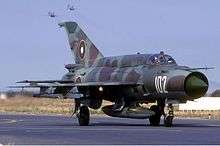
The Bulgarian Air Force received a total of 224 MiG-21 aircraft. From September 1963 the 19th Fighter Regiment of the Air Force received 12 MiG-21F-13s. Later some of these aircraft were converted for reconnaissance as MiG-21F-13Rs, which were submitted to the 26th Reconnaissance Regiment in 1988. In January 1965 the 18th Fighter Regiment received a squadron of 12 MiG-21PFs, some of which also were converted and used as a reconnaissance aircraft (MiG-oboznachevnieto 21PFR). The 26 Regiment reconnaissance aircraft from this squadron were removed from service in 1991, the 15 Fighter Regiment in 1965 received another 12 MiG-21PF fighters and in 1977–1978 operated another 36 refurbished aircraft. This unit received two more aircraft in 1984 and operated them until 1992.
For reconnaissance, a regiment received 26 specialized reconnaissance MiG-21Rs in 1962, and in 1969–1970, 19 Fighter Aviation Regiment received 15 MiG-21m aircraft, which operated in 21 Fighter Aviation Regiment and were removed from active service in 1990. An additional 12 MiG-21MF fighters were received in 1974–1975, with a reconnaissance version of the MiG-21MFR provided to the 26th Reconnaissance Regiment and eksloatirani until 2000, when removed from active service.
From 1983 to 1990, the Bulgaria Air Force received 72 MiG-21bis. Of these, 30 (six new and renovated) are under option with ACS and provided to the 19th Fighter Regiment; the rest are equipped with the "Lazur." This batch was taken out of service in 2000.
Besides fighters, the Air Force has received 39 MiG-21U trainers (one in 1966), five MiG-21US in 1969–1970 and 27 MiG-21UM (new) during 1974–1980, another six refurbished ex-Soviet examples in 1990. In 1982, three MiG-21UM trainers were sold to Cambodia and in 1994 another 10 examples. MiG-21UMs were also sold to India. Other training aircraft were removed from active service in 2000. A total of 38 aircraft were lost in the period 1963–2000.
The last flight of a Bulgarian Air Force MiG-21 took off from Graf Ignatievo Air Base on 31 December 2015. On 18 December 2015, there was an official ceremony for the retirement of the type from active duty.[113]
Known MiG-21 aces
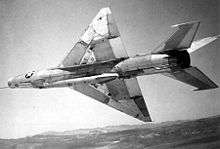
Several pilots have attained ace status (five or more aerial victories/kills) while flying the MiG-21. Nguyễn Văn Cốc of the VPAF, who scored nine kills in MiG-21s is regarded as the most successful.[114] Twelve other VPAF pilots were credited with five or more aerial victories while flying the MiG-21: Phạm Thanh Ngân,[1] Nguyễn Hồng Nhị and Mai Văn Cường (both eight kills); Đặng Ngọc Ngự[1] (seven kills), Vũ Ngọc Đỉnh,[1] Nguyễn Ngọc Độ,[1] Nguyễn Nhật Chiêu,[1] Lê Thanh Đạo,[1] Nguyễn Đăng Kỉnh,[1] Nguyễn Đức Soát,[1] and Nguyễn Tiến Sâm[1] (six kills each), and Nguyễn Văn Nghĩa[1] (five kills).
Additionally, three Syrian pilots are known to have attained ace status while flying the MiG-21. Syrian airmen: M. Mansour[115] recorded five solo kills (with one additional probable), B. Hamshu[115] scored five solo kills, and A. el-Gar[115] tallied four solo and one shared kill, all three during the 1973–1974 engagements against Israel.
Due to the incomplete nature of available records, there are several pilots who have unconfirmed aerial victories (probable kills), which when confirmed would award them "Ace" Status: S.A. Razak[116] of the Iraqi Air Force with four known kills scored during the Iran–Iraq War (until 1991; sometimes referred to as the Persian Gulf War), A. Wafai[117] of the Egyptian Air Force with four known kills against Israel.
For specific information on kills scored by and against MiG-21s sorted by country see the Mikoyan-Gurevich MiG-21 operators page.
See also List of Syrian flying aces, List of Egyptian flying aces
Variants
Operators
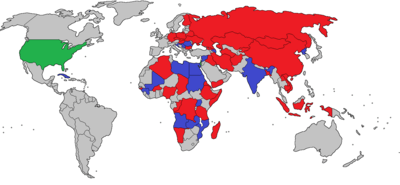
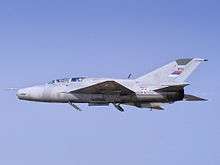
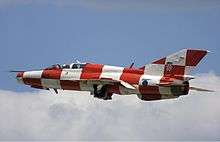
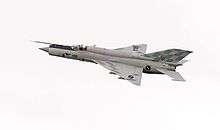

Current operators
This list does not include operators of Chinese copies / licensed manufactured versions known as the Chengdu J-7/F-7. Information is based on Mig-21 (2008).[1]

- National Air Force of Angola: 23 in service as of December 2018.[118]

- Azerbaijani Air Forces: 5 in service as of December 2018.[119]

- Croatian Air Force: 12 aircraft in service as of December 2018.[120] Upgraded in 2003 to MiG-21BisD/UMD standard and refurbished again in 2014. They will remain operational until at least 2022.

- Cuban Revolutionary Air and Air Defense Force: 12 aircraft in service as of December 2018.[121]


- Guinea Air Force: 3 in service as of December 2018.[123]


- Indian Air Force: MiG-21 FL version withdrawn December 2013, MIG-21 PF (MIG-21 FL or Type 77) withdrawn in January 2014. Upgraded MIG-21bis to be retired by 2021–2022.[125][126][127][128]

- Libyan Air Force: 12 aircraft in service as of December 2018.[129]

- Mali Air Force: 9 in service as of December 2018.[129]


- Korean People's Air Force[131] MiG-21F-13, MiG-21PFM, MiG-21MF, MiG-21bis and MiG-21U in service, as well as the similar looking Chengdu J-7.

- Romanian Air Force[132] will be replaced by F-16s from 2017 onwards

- Serbian Air Force and Air Defence: 3 as of service in 2019. planning to replace with MiG 29 variants[133]


- Syrian Arab Air Force[134]
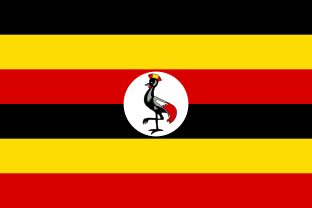
- Ugandan Air Force[135]


Former operators
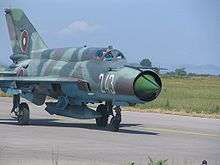
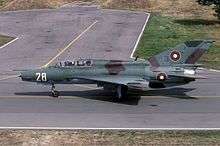
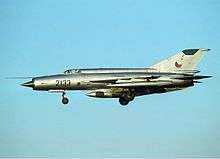
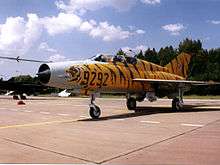
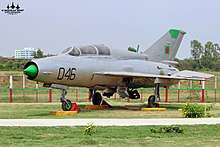
.jpg)










- Czechoslovak People's Air Force: (passed on to the Czech Republic and Slovakia)


- Air Forces of the National People's Army: (passed on to Germany after reunification)






- Hungarian Air Force: 261 MiG-21 bis


- Iranian Air Force: Purchased 12 ex-East German MiG-21PFMs plus four MiG-21Us for training purposes. However, only two MiG-21Us were delivered, the others being embargoed after German reunification.[147]

- Iraqi Air Force: (In Saddam Hussein's Era)

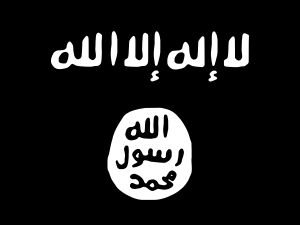
- Military of ISIL: quantity 19 (1 operational).[148][149][150] Originally 3 in operational condition. The Syrian Air Force claimed to have shot down two of them.[151] Other airframes are in various states of disrepair and some of them were being overhauled at the time of their capture.

- Kyrgyzstan Air and Air Defence Force






- Polish Air Force
- Polish Naval Aviation

%3B_Flag_of_Serbia_and_Montenegro_(2003%E2%80%932006).svg.png)
- Air Force of Serbia and Montenegro (passed on to Serbia)

- Slovak Air Force In 1993, after the dissolution of Czechoslovakia, Slovak Air Force obtained 13 MiG-21MAs, 36 MiG-21MFs, eight MiG-21Rs, two MiG-21USs and 11 MiG-21UMs. They were withdrawn in 2003. Some of them are in museums across the country, some are stored and will be destroyed.[154]


- Soviet Air Force
- Soviet Air Defence Force
- Soviet Naval Aviation
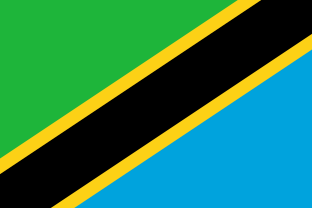
- Tanzanian Air Force




- Vietnam People's Air Force Retired from service in November 2015, put in temporary storage while the Air Force searches for a replacement, possibly the Sukhoi Su-35 or even the American F-16.[156]
.svg.png)
- Yugoslav Air Force (Passed on to Serbia and Montenegro.)

Civilian operators
According to the United States Federal Aviation Administration (FAA), there were 44 privately owned MiG-21s in the U.S. in 2012[157]
By 2013 Draken International acquired 30 MiG-21bis/UM, mostly ex-Polish.[158] In 2017 it operates 30 MiGs.[159]
Use as space launch platform
Premier Space Systems in Hillsboro, Oregon, US, is currently conducting flight tests for NanoLaunch, a project to launch suborbital sounding rockets from MiG-21s flying over the Pacific Ocean.[160]
Specifications (MiG-21bis)
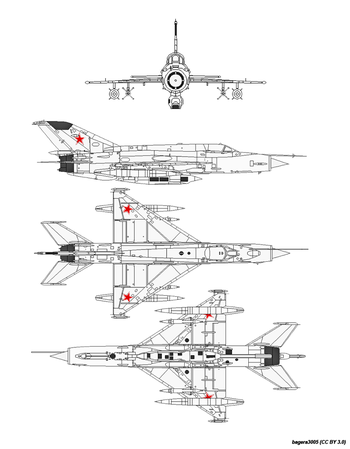
Data from Jane's all the world's aircraft, 1992–93[161]
General characteristics
- Crew: 1
- Length: 14.7 m (48 ft 3 in) excluding pitot boom
- Wingspan: 7.154 m (23 ft 6 in)
- Height: 4.1 m (13 ft 5 in)
- Wing area: 23 m2 (250 sq ft)
- Airfoil: root: TsAGI S-12 (4.2%); tip: TsAGI S-12 (5%)[162]
- Gross weight: 8,725 kg (19,235 lb) with two R-3S missiles
- Max takeoff weight: 8,800 kg (19,401 lb) unprepared or metal planking runway
- 9,800 kg (21,605 lb) paved runway with standard wheels and tyres
- 10,400 kg (22,928 lb) paved runway with larger wheels and tyres
- Powerplant: 1 × Tumansky R-25-300 afterburning turbojet, 40.18 kN (9,030 lbf) thrust dry, 69.58 kN (15,640 lbf) with afterburner
Performance
- Maximum speed: 2,237 km/h (1,390 mph, 1,208 kn) / M2.05 at 13,000 m (42,651 ft)
- 1,300 km/h (810 mph; 700 kn) / M1.06 at sea level
- Landing speed: 250 km/h (160 mph; 130 kn)
- Range: 660 km (410 mi, 360 nmi) clean at 11,000 m (36,089 ft)
- Service ceiling: 17,500 m (57,400 ft)
- Time to altitude: 17,000 m (55,774 ft) in 8 minutes 30 seconds
- Thrust/weight: 0.76
- Take-off run: 830 m (2,723 ft)
- Landing run with SPS and brake parachute: 550 m (1,804 ft)
Armament
- Guns: 1 × internal 23 mm Gryazev-Shipunov GSh-23L autocannon with 200 rounds
- Hardpoints: 4 with a capacity of up to 2,000 kg (4,400 lb) of stores,with provisions to carry combinations of:
- Rockets: S-24
- Missiles:
- Bombs: ::* KAB-500KR TV-guided bomb
- 4 × 500 kg (1,100 lb) bombs
See also
Related development
Aircraft of comparable role, configuration and era
- Dassault Mirage III
- Dassault Mirage F1
- English Electric Lightning
- Lockheed F-104 Starfighter
- McDonnell Douglas F-4 Phantom II
- Northrop F-5
- Saab 35 Draken
Related lists
- Iranian aerial victories during the Iran–Iraq war
- Iraqi aerial victories during the Iran–Iraq war
- List of military aircraft of the Soviet Union and the CIS
- List of fighter aircraft
References
Notes
- "AZ" – abbreviation for Russian "Авиационный Завод" – АЗ (Aviation Plant).
- Now called Nizhny Novgorod.
- Captain Van Coc had scored 9 victories by his meeting with Ho Chi Minh in 1969, he scored 2 USAF reconnaissance drones[35] in December 1969, after Ho Chi Minh's death in September of that year
Citations
- Gordon, Yefim. MiG-21 (Russian Fighters). Earl Shilton, Leicester, UK: Midland Publishing Ltd., 2008. ISBN 978-1-85780-257-3.
- "МиГ-21. Хронология и экспорт. – MilitaryRussia.Ru – отечественная военная техника (после 1945г.)". militaryrussia.ru. Retrieved 2 February 2019.
- "MiG-21 – naddźwiękowy ołówek" (in Polish). Archived 6 June 2011 at the Wayback Machine lotniczapolska.pl, 6 September 2007. Retrieved: 1 December 2010.
- Civil Airworthiness Certification: Former Military High-Performance Aircraft, United States Department of Transportation, Federal Aviation Administration.
- Dunnigan, James F. How to Make War, A Comprehensive Guide to Modern Warfare in the 21st Century, Fourth Edition. Harper Collins Publishers Inc. 2003. ISBN 978-0060090128
- "Afterburner/Engine simulation question - ED Forums".
- Král, Martin. "MiG-21BIS." Archived 2 July 2017 at the Wayback Machine Soviet Hammer, 6 April 2012. Retrieved: 28 June 2012.
- "Chengdu J-7 (J-7I)". www.airwar.ru. Retrieved 2 February 2019.
- Mehrotra, Santosh. India and the Soviet Union: Trade and Technology Transfer. Cambridge, UK: Cambridge University Press, 1990. ISBN 978-0-521-36202-3.
- Rakshak, Bharat. "The Canberra and the MiG-21." Archived 8 June 2011 at the Wayback Machine Retrieved 1 December 2010.
- "Chapter Six: Asia". The Military Balance. 119 (1): 266–272. 15 February 2019. doi:10.1080/04597222.2018.1561032. ISSN 1479-9022.
- Taneja, Kabir. "The Trouble With India's MIG-21 Fighter Jets". The New York Times, 8 August 2013.
- Civil Airworthiness Certification: Former Military High-Performance Aircraft, United States Department of Transportation, Federal Aviation Administration. p. 2-2
- "MiG-21 FL flies into IAF history". The Times of India, 11 December 2013.
- "1999 Kargil Operations". Archived from the original on 2 February 2007. Retrieved 14 November 2014.
- "Indian Air Force Scrambles Fighter Jets as Turkish Plane Sparks Alert". NDTV.com. Retrieved 14 November 2014.
- Till, Geoffrey. Globalisation and Defence in the Asia-Pacific. London: Taylor & Francis, 2008. ISBN 978-0-415-44048-6.
- "Air Force History." Globalsecurity. Retrieved: 1 December 2010.
- "The 1971 Liberation War: Supersonic Air Combat." Archived 7 July 2011 at the Wayback Machine Bharat-Rakshak.com. Retrieved: 1 December 2010.
- Coggins, Ed. Wings That Stay on. Nashville, Kentucky: Turner Publishing Company, 2000. ISBN 978-1-56311-568-4.
- Cooper 2004 .
- "1999 Kargil Conflict". Global Security.
- Dawn.com (27 February 2019). "2 Indian aircraft violating Pakistani airspace shot down; pilot captured". DAWN.COM. Retrieved 20 May 2020.
- Davies 2012, p. 48.
- Michel 1997, p. 81.
- Toperczer 2001, pp. 6, 77.
- Toperczer 2001, p. 27.
- Toperczer #25 2001, p. 12.
- Toperczer #25 2001, p. 88.
- Toperczer #29 2001, p. 84.
- Boniface 2005, p. 190.
- Michel 1997, pp. 41, 78, 153.
- Boniface 2005, p. 192.
- Michel 1997, pp. 83, 155.
- Toperczer (29) p. 86
- Sander Peeters. "Vietnamese Air-to-Air Victories, Part 1". Retrieved 14 November 2014.
- "Vietnamese Air-to-Air Victories, Part 2." ACIG. Retrieved: 25 August 2013.
- Michel III pp. 42, 43
- "Vietnamese Aces – MiG-17 and MiG-21 pilots". Ace pilots. Retrieved 9 August 2013.
- "MiG-21 against the Phantom". Survicinity. Archived from the original on 29 November 2014. Retrieved 14 November 2014.
- Michel 1997, p. 149.
- Michel 1997, p. 186.
- Michel 1997, p. 187.
- "Vietnamese Air-to-Air Victories, Part 2". ACIG. Retrieved 14 November 2014.
- Anderton 1987, pp. 70–71.
- "The plaque on SSgt Turner's grave." waymarking.com. Retrieved: 1 December 2010.
- "Linebacker II." The Colorado Springs Gazette, 16 July 2007.
- Toperczer #25 2001, p. 61.
- Toperczer #25 2001, p. 66 photo.
- Toperczer #25 2001, p. 66.
- Michel 2002, pp. 205–6.
- Toperczer #25 2001, p. 67.
- Michel 2002, p. 213.
- Toperczer, István (20 November 2012). MiG-21 Units of the Vietnam War. ISBN 978-1-78200687-9.
- "Nga nói gì về cuộc đấu MiG-21 và F-4 ở Việt Nam(2)". Kiến thức. 27 December 2013. Retrieved 14 November 2014.
- "Picture". VKO. Archived from the original on 3 February 2014. Retrieved 1 December 2018.
- "Egyptian Air-to-Air Victories since 1948". ACIG. Retrieved: 25 August 2013.
- Окороков А. В. Война на истощение // Секретные войны Советского Союза: первая полная энциклопедия. — М.: ЭКСМО, 2008. — С. 81.
- http://aces.safarikovi.org/victories/victories-sssr-war.of.attrition.air.to.air.victories.pdf
- Nicolle and Cooper, 32
- Sachar, Howard: Israel and Europe: An Appraisal in History, p. 171-172
- Зенитные ракетные войска в войнах во Вьетнаме и на Ближнем Востоке (в период 1965–1973 гг.). М.: Воениздат, 1980. С. 215
- Pollack 2004, p. 124.
- Herzog 1975, p. 259.
- "Потери ВВС Израиля в Ливане". War online. Archived from the original on 17 April 2014. Retrieved 14 November 2014.
- "Syrian Air-to-Air Victories since 1948." ACIG. Retrieved: 25 August 2013.
- "The Aviationist " [Video] This is what being in the trajectory of a bomb dropped by a Syrian attack plane looks like". The Aviationist. 31 October 2013. Retrieved 14 November 2014.
- "The Boresight". Retrieved 14 November 2014.
- Brown Moses (4 September 2012). "Brown Moses Blog". Retrieved 14 November 2014.
- R.S (10 November 2014). "Luftwaffe A.S". Retrieved 14 November 2014.
- Harro Ranter. "ASN Aircraft accident 10-NOV-2014 Mikoyan-Gurevich MiG-21bis 660". Retrieved 14 November 2014.
- "Rebels shoot down Syrian warplane". Reuters.
- "SyAAF MiG-21 Shot Down (2016-03-12)". luftwaffeas.blogspot.fr. 13 March 2016.
- R.s (5 March 2017). "Luftwaffe A.S: SyAAF MiG-21bis Shot Down (2017-03-04)". luftwaffeas.blogspot.com.br. Retrieved 4 June 2017.
- Cooper and Bishop, 2004, pp. 85–88.
- Cooper and Bishop 2004, pp. 87–88.
- Gordon and Dexter 2008, pp. 390–392.
- Boring, War Is (8 September 2015). "Grounding the Ayatollah's Tomcats". medium.com. Retrieved 2 February 2019.
- "Libyan Conflict: Fixed-wing Combat Aircraft make an Appearance." The Boresight, 20 March 2011. Retrieved: 9 May 2011.
- "MiG-21UM/bis Fishbed K." Aviation Safety Net. Retrieved: 9 May 2011.
- "Further Egyptian MiG-21 deliveries to the Libyan Air Force". 12 March 2015.
- "The Aviationist " Photo proves Libyan Mig-21s (not Egyptian aircraft) have conducted air strikes in Benghazi recently". The Aviationist. 17 October 2014. Retrieved 6 April 2015.
- "Retired general launches war against Islamists in eastern Libya". janes.com. Retrieved 6 April 2015.
- "Operation Dignity aircraft crashes near Beida". Libya Herald.
- "Libya fighters say enemy plane shot down". www.aljazeera.com.
- "MiG-21 Crashes in Libyan City of Tobruk." Vice News. Retrieved: 2 September 2014.
- "Libyan fighter jet crashes into city block, kills pilot, kid." RT News
- "Haftar Air Force MiG-21 strikes Mitiga Airport in Tripoli". 9 April 2019.
- "Libyan government forces have shot down a Libyan National Army MiG-21 fighter jet over Tripoli". 15 April 2019.
- Ranter, Harro. "Incident MiG-21MF , 14 Apr 2019". aviation-safety.net.
- "Un avion MiG-21 de l'Armée nationale libyenne abattu au sud de Tripoli". 15 April 2019.
- "Lostarmour ID: 20474". lostarmour.info.
- Cooper, Tom and Gianfranco Lanini. "Ogaden War, 1977–1978." ACIG, 10 February 2008. Retrieved: 13 September 2012.
- Cooper, Tom., "Wings over Ogaden, 2015, ch. 3
- Cooper, Tom & Fontanellaz, Adrian, "Ethiopian-Eritrean Wars Volume 1, 2018, ch. 4
- "Prisioneros a color". Havanaluanda. 14 November 2013. Retrieved 14 November 2014.
- "Angola: Claims and Reality about SAAF Losses". Retrieved 14 November 2014.
- "Mirage F1 in SAAF Service". Retrieved 14 November 2014.
- "Angolan and Soviet Pilots". Retrieved 14 November 2014.
- milhaus. "MIG21bis". Archived from the original on 19 October 2017. Retrieved 14 November 2014.
- "South Africa returns MiG-21 fighter jet to Angola". 20 September 2017.
- Cooper, Tom; Pit, Weinert (2 September 2003). "Zaire/DR Congo since 1980". ACIG. Archived from the original on 17 February 2014.
- "Letelice MiG-21 u RV i PVO i njihove sudbine". Retrieved 14 November 2014.
- "Avijacija bez granica" (in Serbian). avijacijabezgranica.com. Retrieved: 1 December 2010.
- "Austrian Radar Plots." ACIG. Retrieved: 1 December 2010.
- Croatian MiG-21 at aviatia.net
- "MiGs Over Croatia." ACIG. Retrieved: 1 December 2010.
- "RoAF aircraft". Archived from the original on 18 July 2017.
- "Romania Finally Settles On Portuguese F-16s". Aviation International News. Retrieved 14 November 2014.
- "Romania buys Portuguese F-16s". Retrieved 14 November 2014.
- Civil Airworthiness Certification: Former Military High-Performance Aircraft, United States Department of Transportation, Federal Aviation Administration. p. 2-2.
- Dr Sēan Wilson/Prime Images (2016): Bułgarskie "Mieczniki" odchodzą, "Lotnictwo" Nr 2/2016, p.16-17 (in Polish)
- "North Vietnamese Aces." AcePilots.com. Retrieved: 1 December 2010.
- "Syrian Air-to-Air Victories since 1948." Archived 10 July 2013 at the Wayback Machine acig.org. Retrieved: 1 December 2010.
- "Iraqi Air-to-Air Victories since 1967." Archived 10 July 2013 at the Wayback Machine ACIG.Retrieved: 1 December 2010.
- "Egyptian Air-to-Air Victories since 1948." Archived 10 April 2009 at the Wayback Machine ACIG. Retrieved: 1 December 2010.
- Hoyle Flight International 4–10 December 2018, p. 38.
- Hoyle Flight International 4–10 December 2018, p. 39.
- Hoyle Flight International 4–10 December 2018, p. 42.
- Hoyle Flight International 4–10 December 2018, p. 43.
- Hoyle Flight International 11–17 December 2012, p. 49.
- Hoyle Flight International 4–10 December 2018, p. 45.
- "World Air Forces 2004 pg. 62". Flightglobal Insight. 2004. Retrieved 2 July 2015.
- Simha, Rakesh Krishnan (27 June 2014). "Sukhoi-30MKI is India's fallback fighter". Russia & India Report. Archived from the original on 22 July 2014. Retrieved 17 July 2014.
- "IAF Transformation: Happening but delay on MMRCA is worrying". India Strategic. October 2013. Retrieved 17 July 2014.
- Eshel, Tamir (18 January 2015). "The Indian Air Force Receives its First Indigenous 'New' Fighter". Defense Update. Retrieved 27 January 2015.
- Banerjee, Ajay (20 July 2018). "MiG-21 a relic that continues to fly". The Tribune. Retrieved 27 February 2019.
- Hoyle Flight International 4–10 December 2018, p. 49.
- Martin, Guy (4 November 2013). "Mozambican Air Force to get eight overhauled MiG-21s - defenceWeb". www.defenceweb.co.za.
- Hoyle Flight International 4–10 December 2018, p. 51.
- Hoyle Flight International 4–10 December 2018, p. 53.
- Hoyle Flight International 4–10 December 2018, p. 54.
- Hoyle Flight International 4–10 December 2018, p. 56.
- Hoyle Flight International 4–10 December 2018, p. 57.
- Hoyle Flight International 4–10 December 2018, p. 60.
- "ФОТООКО: УНИКАЛНО АВИОШОУ ЗА 102 ГОДИНИ ВВС". www.pan.bg.
- "МиГ-21 отново във въздуха". www.pan.bg.
- "ФОТООКО: И МиГ-21бис във въздуха!". www.pan.bg.
- http://forms.flightglobal.com/WorldAirForces2015?product=PREM&mode=DOWNLOAD&DMDcode=FGWC4&fcid=%7B05ceef25-b72e-4bea-9a83-a7ab7d02e55a%7D_FC078_PREM_201412&fcfileext=pdf
- "China Mig-21MF Trade." Archived 21 April 2011 at the Wayback Machine AirForceWorld.com. Retrieveda; 5 November 2011.
- "China stops production of J-7 fighter jets." Archived 27 October 2018 at the Wayback Machine AirForceWorld.com. Retrieveda; 3 June 2013.
- "World Air Forces 1994 pg. 38". Flightglobal Insight. 1994. Retrieved 21 March 2015.
- "World Air Forces 2004 pg. 38". Flightglobal Insight. 1994. Retrieved 21 March 2015.
- "Eritrea". Scramble magazine. Retrieved: 19 May 2013.
- "Only one machine was flying with Luftwaffe registration: To scrapping". German Airforce. Reviewed 2 February 2013.
- "IRIAF MiG-29 above Teheran – Iranian Fulcrums". kamov.net. Archived from the original on 4 March 2016. Retrieved 29 November 2015.
- "Vehicles and equipment captured and operated by the Islamic State inside Syria". Oryx Blog. 10 November 2014. Retrieved 14 April 2016.
- "Vehicles and equipment captured and operated by the Islamic State inside Iraq". Oryx Blog. 22 November 2014. Retrieved 14 April 2016.
- "BBC News – Islamic State 'training pilots to fly fighter jets'". BBC News. 17 October 2014.
- "Syria says shoots down two of three Islamic State jets". Reuters. 22 October 2014. Retrieved 22 October 2014.
- "World Air Forces 2013 – Pictures & Photos on FlightGlobal Airspace." Flightglobal.com, 11 December 2012. Retrieved: 28 July 2013.
- PALOQUE The MiG 21 The Mikoyan-Gurevitch Fishbed (1955–2010) December 2009, p. 69.
- Culak, Josef. " (in Slovak). Archived 15 October 2012 at the Wayback Machine culak.blog. Retrieved: 13 September 2012.
- "We didn't know what 90 percent of the switches did". Archived from the original on 16 January 2014. Retrieved 14 November 2014.
- www.nguyentandung.org (18 November 2015). "KQND Việt Nam chuẩn bị vĩnh biệt tiêm kích MiG-21".
- "MiG-21 in U.S." FAA Registry. Retrieved: 13 September 2012.
- Informacje "RAPORT Wojsko Technika Obronność" Nr. 11/2013, p.76 (in Polish)
- "Draken International - Draken International". www.drakenintl.com.
- "Vintage fighters return as launch platforms." citizensinspace.org, March 2012. Retrieved: 13 September 2012.
- Lambert, Mark; Munson, Kenneth; Taylor, Michael J.H., eds. (1992). Jane's all the world's aircraft, 1992–93 (83rd ed.). Coulson, Surrey, UK: Jane's Information Group. pp. 214–216. ISBN 978-0710609878.
- Lednicer, David. "The Incomplete Guide to Airfoil Usage". m-selig.ae.illinois.edu. Retrieved 16 April 2019.
Bibliography
- Anderton, David A. North American F-100 Super Sabre. Oxford, UK: Osprey Publishing Limited, 1987. ISBN 0-85045-662-2.
- Boniface, Roger. Fighter Pilots of North Vietnam: An Account of their Combats 1965 to 1975. Gamlingay, Sandy, UK: Authors On Line, 2005. ISBN 978-0-7552-0203-4.
- Cooper, Tom and Farzad Bishop. Iranian F-14 Tomcat Units in Combat (Osprey Combat Aircraft #49). Oxford: Osprey Publishing, 2004. ISBN 978-1-78200-709-8.
- Davies, Steve. Red Eagles: America's Secret MiGs. Oxford, UK: Osprey Publishing Limited, 2012. ISBN 978-1-84603-970-6.
- Eden, Paul. The Encyclopedia of Modern Military Aircraft, London: Amber Books, 2004. ISBN 1-904687-84-9
- Gordon, Yefim. Mikoyan-Gurevich MiG-15: The Soviet Union's Long-Lived Korean War Fighter. Hinckley, UK: Midland, 2001. ISBN 1-85780-105-9.
- Gordon, Yefim. Mikoyan MiG-21 (Famous Russian aircraft). Hinckley, UK: Midland, 2008. ISBN 978-1-85780-257-3.
- Gordon, Yefim and Keith Dexter.Mikoyan Mig-21 (Famous Russian Aircraft). London: Ian Allan Publishing, 2008. ISBN 978-1-85780-257-3.
- Herzog, Chaim. The War of Atonement. Boston: Little Brown and Company, 1975. ISBN 0-316-35900-9.
- Hobson, Chris. Vietnam Air Losses, United States Air Force, Navy and Marine Corps Fixed-Wing Aircraft Losses in Southeast Asia 1961–1973. Midland Publishing, England; 2001. ISBN 1-85780-115-6.
- Hoyle, Craig. "World Air Forces Directory". Flight International. Vol. 180, No. 5321, 13–19 December 2011, pp. 26–52. ISSN 0015-3710.
- Hoyle, Craig. "World Air Forces Directory". Flight International. Vol. 182, No. 5321, 11–17 December 2012, pp. 40–64. ISSN 0015-3710.
- Hoyle, Craig. "World Air Forces Directory". Flight International. Vol. 194, No. 5665, 4–10 December 2018, pp. 32–60. ISSN 0015-3710
- Michel III, Marshall L. Clashes; Air Combat Over North Vietnam 1965–1972. Annapolis, Maryland, USA: Naval Institute Press, 2007, First edition 1997. ISBN 1-59114-519-8.
- Michel III, Marshall L. The 11 days of Christmas. New York: Encounter Books, 2002. ISBN 1-893554-27-9.
- Nicolle, David and Tom Cooper. Arab MiG-19 and MiG-21 Units in Combat (Osprey Combat Aircraft #44). Oxford, UK: Osprey Publishing Limited, 2004. ISBN 978-1-84176-655-3.
- Pollack, Kenneth M. Arabs at War: Military Effectiveness, 1948–1991 London: Bison Books, 2004. ISBN 0-8032-8783-6.
- Toperczer, István. MiG-17 and MiG-19 Units of the Vietnam War (Osprey Combat Aircraft #25). Oxford, UK: Osprey Publishing Limited, 2001. ISBN 978-1-84176-162-6.
- Toperczer, István. MiG-21 Units of the Vietnam War (Osprey Combat Aircraft, 29). Oxford, UK: Osprey Publishing Limited 2001. ISBN 1-84176-263-6.
- Wilson, Stewart. Combat Aircraft since 1945. Fyshwick, Australia: Aerospace Publications, 2000. ISBN 1-875671-50-1.
External links
| Wikimedia Commons has media related to Mikoyan-Gurevich MiG-21. |